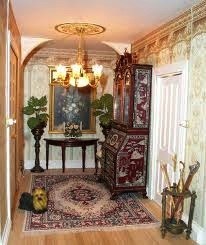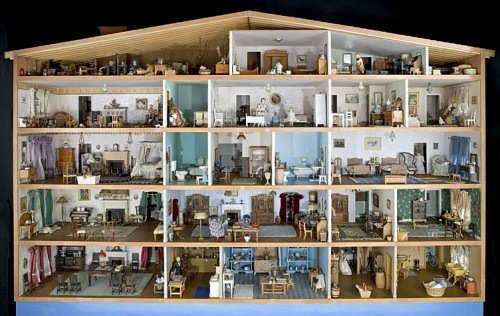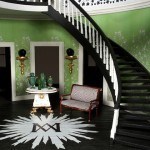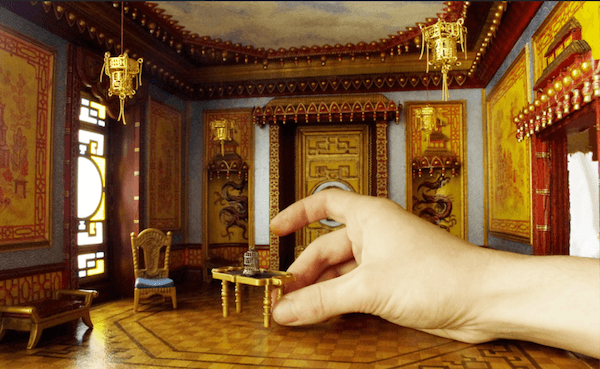
Tim Sidford (Sweetington) commented about this Recency Chinese room box, “To be honest I’ve outgrown the place.”
Regency Era 1811 – 1820
For miniature enthusiasts, the Regency Era in the United Kingdom was brief, only nine years. King George III was deemed unfit to rule and his son, the Prince of Wales, ruled as Prince Regent. On the death of his father in 1820, the Prince Regent became George IV.
The Odd Couple
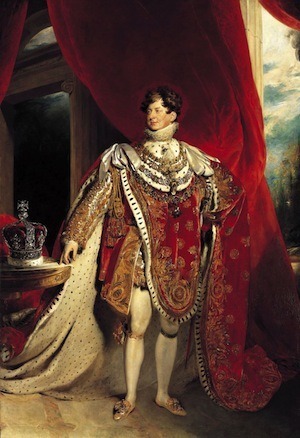
King George IV, formerly the Prince of Wales and The Prince Regent, in his coronation robes in 1821.
The Napoleonic Wars raged on, forcing much of the European nobility to raise cash by selling precious works of art. The future King took advantage of their misfortune to enlarge the Royal Collection.
While still the Prince Regent, he joined forces with architect John Nash. They embarked on a building program that would nearly bankrupt the country. It was a true symbiotic relationship, each attempting to out-do the other with extravagant designs, ultimately giving us the Royal Pavilion at Brighton, Windsor Castle, and Buckingham Palace.
The Prince Regent had such a fondness for pageantry, that when King, he helped develop the ceremonial side of the monarchy that is so loved today.
The building spree created vast interior spaces with high ceilings. The Prince never saw a blank wall he didn’t want to cover with something colorful. Technology to the rescue! New mechanical processes allowed for greater use of wallpaper and fabrics.

Not all Regency décor is “in your face.” The two-story blue hall and stairway, found on Dolls House Grand Design, is an example.
Regency Design Elements
Here are a few design elements to keep in mind when working on a Regency miniature:
Wallcoverings – mass production allowed for multiple patterns, even in the same room
Fabrics – mass production also produced a greater variety of weaves and textures.
Decorations – bold use of Greek and Egyptian motifs, garlands and tassels
Wood – mahogany and rosewood
Colors – exotic and vibrant – vivid blues, greens, and reds
Furniture – sumptuous gilding used widely
Lighting – candles early on; oil later
Chinoiserie
First appearing in the 17th century, chinoiserie was the European interpretation of Chinese artistic traditions, especially in the decorative arts. It became popular due to the rise in trade with China and East Asia. Whimsical and light in subject matter and appearance, chinoiserie provided an option to the more rigid classical styles that were prominent.
Chinoiseries was not universally admired. Some members of society saw the style as “…a retreat from reason and taste and a descent into a morally ambiguous world based on hedonism …
So, of course, the Prince Regent loved it. You will find examples of chinoiserie throughout Regency and early Georgian décor.
Notable Miniatures
Do a search of Regency dollhouses and dolls houses on the Internet; you’ll get a sizable directory of hits. Here are 2 sites that may not be on the first or second screen:
Jane Austen In Vermont has the Faith Bradford’s 23-room Regency dollhouse and background on her inspiration;
Jane Austen’s World does not have a dollhouse, but there is lots of good stuff to learn about the times. (I like learning stuff). This site also has links to Thomas Hope, a leading designer of the period. If you get enthused about doing a Regency project, you’ll want to refer to his work as a reference.
So there it is. I hope this information is useful to you.
Susan Downing, with Patrick Owens
____________________________________________________________________________________
I invite you to visit my Etsy Shop where I offer many accessories and pieces of furniture in 1:12 scale.



